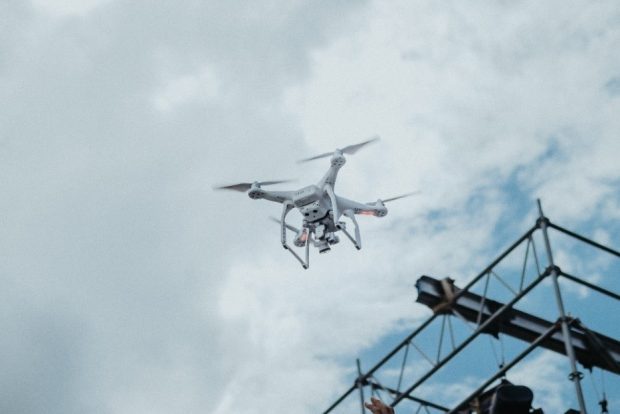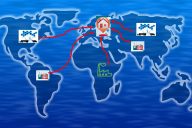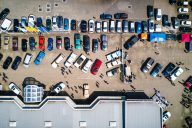What are drones? And how can they be used now and in the future. By using drones the border could be monitored automatically, post packages could be delivered to recipients using a straight line distance route, cities and fire departments could pre-install drones in every neighborhood to guide their brigades and monitor the situation. Furthermore, drones will be doing many different jobs soon.
From manual processes to new technology
It is year 2020, and we are facing a global pandemic. When entering to public spaces, we should wear a face mask and, if only possible, reduce our social contacts to a minimum. Whether we like it or not, we are driven to utilize various technology – do online shopping for groceries; order ready-made meals from local restaurants; exercise in front of a PC screen; book an e-doctor appointment, and constantly monitor our smart phone for COVID exposure alerts.
Digitalization is already enabling many things to be consumed without leaving our home. But the back-office processes enabling these B2C services are getting busier all the time. In many cases, these processes still require manual steps – for example, in the form of collect and deliver, or collect and grab yourself. Collectors fill in food baskets in grocery stores, and then couriers drive these packages up to the door of our house where they drop them off, often without visible contacts. What if there would be a way to streamline these manual processes with a new technology even further? With drones, maybe?
What are drones?
Drone, or an Unmanned Aerial Vehicle, is an aircraft without a human pilot inside. It can be remotely piloted or totally autonomous, and be equipped with various other gadgets needed to perform the mission it is designed for. The most common gadget is still being a high-resolution camera known from those leisure drones available from various electronic stores. But that’s not all.
There are also commercial drones which are equipped to complete different kinds of use cases and tasks, from lifting and delivery to very specific scenarios such as possibly acting as a mobile cellular network base station in emergency areas. The technology and regulation are starting to mature for long distance BVLOS (Beyond the Visible Line of Sight) operations, which will enable significantly more use cases for drones.
How can drones be used?
But the future perspective for using drones could be even wider, if we stretch from the private sector services into the needs of the public sector. There are plenty of actors in governmental and municipality sector which might benefit from using drones. For example
- customs and border forces could monitor the border automatically or from the operations centers, without sending the troops to patrol on the border zone
- postal offices could deliver packages to recipients using a straight line distance route, without worrying about traffic jams
- cities and fire departments could pre-install drones in every neighborhood to guide their brigades and monitor the situation already on their way to the emergency site.
There are also multiple other opportunities.
Drone software for public sector use
My Master’s thesis focused on conducting a market analysis of the drone industry in the European public sector context. It was done to support an initiative to develop a drone software for public sector use. Based on the findings, it seems that the business environment is becoming more favorable for emerging technologies and completing those tasks that previously seemed fantastic and far-away, but recently have become vital for the Western society to keep running during the pandemic times in order to support our everyday lives.
This change is helped by European wide drone regulation being developed by EU in order to support these new possibilities, as well as the population ageing, and urbanization driving more people to the cities, which brings more pressure on services and the customers closer to these services to be consumed.
At the same time, based on CompTIA research from the US market, drone operators are beginning to purchase the drone management-as-a-service (over building the solution from different components by themselves), which might reduce the time-to-market in Europe. This is what we can see as the firm signs of development in this industry, and these signs are only accelerating.
Now and in the future
Now after completing my studies, it is nice to realize that are we going to see drones doing different job already soon – delivering our medicine form pharmacies, police monitoring mass events and crowd behavior, and central kitchens delivering food to the elderly or handicapped to their homes? There are lots of possibilities, but this time is right for the emerging technologies. So let’s to look into the sky, unless it is something more hidden from our sight.
About the author

Samuli Kipponen
Samuli Kipponen is a fresh MBA graduate from Master´s Programme in Business Informatics at Metropolia UAS. Samuli completed his Master´s thesis project for the Innovation Hub at Metropolia UAS focusing on Smart Mobility that started an initiative to develop a drone software for public sector use. The outcome of Samuli´s study is the market analysis for applying for funding for the drone software initiative.
References
Kipponen, S. (2020). Defining the Market Potential of Industry Specific Drone
Software. [PDF] Master´s thesis. Metropolia University of Applied Sciences.
CompTIA 2019. The Drone Market: Insights from Customers and Providers. [Online]
(Accessed 10th of November 2020)
European Commission 2020a. Unmanned Aircraft. [Online]
(Accessed 7th of October 2020)
Ericsson 2020. Ericsson mobile network-on-a-drone PoC could transform emergency response. [Online] (Accessed 13th of January 2021)









Ei kommentteja